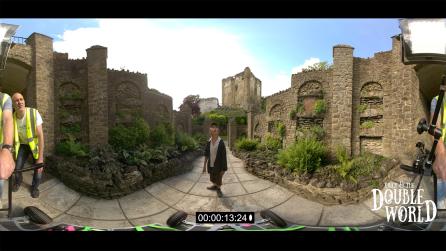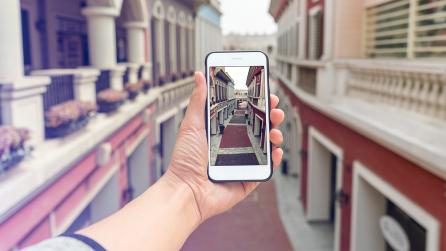The Big Interview: Tim Dillon, Head of VR & Immersive Content, MPC
Moving Picture Company - or MPC as it’s more commonly known today - has spent almost half a century establishing itself as a world-leading visual effects (VFX) business. And, since 2014, that work has included significant virtual reality (VR) projects.
As part of our series on VR, Foundry Trends sat down with Tim Dillon, Head of VR & Immersive Content at MPC, to discuss how far VR content has come - and the challenges that remain.
Foundry Trends (FT): When did MPC first start thinking seriously about creating VR content?
Tim Dillon (TD): It’s been about four years, but it feels more like 40 - which is probably the same for most people in the VR business, because just so much has advanced in that time.
We started with a project we made for Chrysler at the 2014 Los Angeles Auto Show, which was a real-time project using Unreal Engine. We started with the challenge of showing a Chrysler 200 model expand into three of four hundred pieces, transferring that into a game engine, and creating an interactive experience. We took it to The Los Angeles Auto Show using a real car and the Oculus DK2 and it got some really good feedback.
Around the same time we also worked on a project called Catatonic with Vrse.works (now Here Be Dragons) - a horror piece in which the viewer is pushed around an insane asylum in a wheelchair. It was one of the early breakout VR hits, but it was made before a lot of the stitching tools we have now existed - so we had to build those from scratch.
That was a real launching point, and at the time we were able to share some of the findings back with companies like Foundry to help the broader development of VR.
FT: Are there any projects during that time that really stood out?
TD: A lot of the best work we’ve seen in 360 or immersive has been within the music industry. When we finished doing Catatonic, we began working on a music video with U2, which ended up becoming a much larger project.
Chris Milk (director and co-founder of Here Be Dragons) was super-ambitious. He was experimenting with Vice around the concept of VR news, so had cameras all over the world, and he put a call out for U2 fans across the globe to sing the song to these cameras. Our job was to bring that all back together into one piece.
This is quite typical of how these projects come about - they’re often not launched in a traditional way. It might come from the vision of a director, or from the ambitions of a brand. That’s true of the project we just finished with Samsung around the PyeongChang Winter Games.
Our brief was to make something highly cinematic in VR, and we went on a six-month journey with Samsung to make that happen - ending with a theme-park ride piece that’s designed to be viewed in a 4D chair.
FT: How hard is it to create good content in VR?
TD: It’s getting easier, depending on what you’re creating. “Hard” is probably the wrong way to look at it - it takes a lot of craft and expertise. That’s why MPC have such an important role to play.
Over and over again, content makers and content commissioners are trying to make content with as many people as possible and spreading budget as far as they can, but it’s not hitting the quality mark they need.
It’s budget-dependent, too. The number of different distribution channels makes it difficult - you have to marry up how many places your audience is in, versus how big you can go with your ambitions. There’s always a cap to how many people you can get your work in front of.

FT: What are some of the technical challenges you’re facing? And what else needs to be improved?
TD: Making a CG human look ‘real’ is one of the great challenges of traditional VFX, but in VR it’s exponentially harder. You’re standing right in front of the work - way closer than you are when you’re watching a movie, for example - so everything is more exposed.
Budget, time and craft all needs to stretch further in VR, to make it more convincing, but we’re taking the challenge on. In our work with Samsung, we’re using a mix of photo-real and stylised content to ride the line.
There’s a long laundry list of things from a hardware perspective, too. We’d love to see Oculus, Vive, Google, Samsung, Lenovo – all the hardware makers – create standalone headsets without cables, that work as well as the tethered headsets. We realise that’s not an easy challenge, though.
FT: If these challenges can be overcome, where do you see VR heading?
TD: In next five years we’re going to see the VR world diffuse, becoming simply ‘immersive content’ that can be viewed on a variety of devices in a variety of ways. But we’re a strong believer in keeping people excited about VR in the meantime.
Location-based content is helping us do this. Experiences like the VOID’s Star Wars: Secrets of the Empire are getting people into shopping malls and getting them familiar with the content—giving the format life until the hardware can properly catch up.
At MPC, we’re doubling, tripling, or even quadrupling the amount of VR work we’re doing every year. It’s not slowing for us, and the rise of augmented reality (AR) and mixed reality (MR) is effectively doubling that again. We think that volumetric capture – being able to shoot fully 3D subjects that the viewer can walk around and see at all angles – is something that's really going to step things up a gear.
FT: Is everything moving towards MR?
TD: I hope so. MR’s definition for me is content that’s aware of its environment - like Microsoft’s HoloLens, and the recently announced Magic Leap One for instance. At the moment it’s all evolving a bit faster than anyone can label it, but there are some really smart people working in this space who will bridge the marketing problem.
We’re all waiting for Apple to come out with a headset. That has potential to be a big consumer moment but none of us really knows when that will happen.

FT: What do you think is driving change in the industry?
TD: The VR and immersive world is one of the most diverse spaces anyone is working in - you have people from all walks of life, and all kinds of creative industries. But the rug is consistently being pulled, with new technology coming in and fundamentally changing the sector.
The best creatives work with that, however - they react and figure out where to go next. There are great advertising creatives and filmmakers, with a grip on technology, driving change by themselves.
Alejandro Iñárritu and Emmanuel Lubezki (the Oscar winning director and cinematographer behind Birdman and The Revenant) are prime examples. Their project Carne y Arena (Flesh and Sand) is an amazing piece that catapults the viewer into the narrative and lets them view it in a number of ways. The free-roam aspect of it is incredibly exciting and it’s no surprise it was awarded a special Academy Award. It’s the kind of work that will inspire others.
FT: You’ve touched on some of your favourite immersive projects, but what MPC work is closest to your heart?
TD: It has to be The Last Goodbye, which we premiered at Tribeca Film Festival last year. It’s a room scale, free-roam piece for the USC Shoah Foundation, which was set up after Schindler’s List was made, with the intention to capture testimony from Holocaust Survivors. Our project transports you inside the Majdanek concentration camp with survivor Pinchas Gutter as your guide.
The Last Goodbye sums up a lot of what we’ve talked about in this interview. We developed Pinchas’ capture to ensure he’s always eye-to-eye with you, creating a real emotional resonance. We were lucky enough to pick up a Lumiere Award for the project, and being there to pick it up alongside the likes of Pixar really shows how far VR has come.


